The Very Large Array
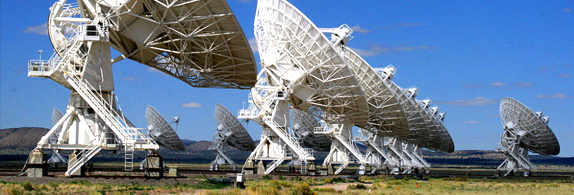
At the Eagle Guest Ranch Café in Datil, Christmas tree hunters, weary from slogging in the snow of the Sawtooth Mountains, could settle down to hamburger steaks by the big fire and overhear muddy cowboys worrying about getting hay to cattle and, at the same time, catch hints of conversations among astrophysicists from the Very Large Array (VLA). It was always one of those deep-rooted New Mexican encounters, high science mingling with the ancient arts of ranching over hot mugs of coffee and supper on the edge of the Plains of San Agustin in Catron County.
The 27 dish antennas, each painted bone white and weighing 209 metric tons, make up one of the most powerful radio telescopes on earth, and are a part of a wider system of antenna dishes that stretch from Hawaii to the Virgin Islands. They listen in on radio waves coming from distant galaxies,
These huge ears into the heavens, with dishes 25 meters across seem in certain weathers to be blooming out of the scrub plains of San Agustin, like lilies transformed into healing mushrooms. They listen in on radio waves coming from distant galaxies farther away than imagination can conceive.
The dishes are arrayed along Y-shaped railroad tracks. The closer together they are the wider their range, and the farther apart they are, the more focused and specific their “view.” The machinery of moving them and placing them exactly where they should be is almost as fascinating as the antennae themselves – huge jacks on wheels that lift and cart the antennae and then place them in their required stations with scientific precision.
When you drive from Magdalena west to Datil, New Mexico highway 60 gives you views of the VLA from many perspectives. Last weekend on that road something close to a plague of grasshoppers distracted us for awhile, but the antennae spread out like a gigantic shrine to the mysteries of space and time and, when we drove in for a closer look, the contrast between the upward gaze of listening machines and the huge openness of the land around it felt to me like a meditation practice in which I was somehow invited to partake.
Construction on the VLA began in l973. It took seven years to complete. A decade later it was time to upgrade computers and connections. “Advancing technology has revealed more and more of the Universe to us over the past few decades….The VLA is now a million times more sensitive than the radio telescopes that made landmark surveys of the sky in the l960s,” Jim Condon, of the National Radio Astronomy Observatory, said in a release from New Mexico Tech which administers the VLA. “The sensitivity and resolution of the VLA, following its decade-long upgrade, make it possible to identify the specific objects responsible for nearly all of the radio background emissions coming from beyond our own Milky Way Galaxy,”
As you walk around outside the VLA visitor center and see the great disks listening to the sky, you come to realize that the radio waves they hear from the quasars, black holes, galaxies, supernovas, hydrogen gas clouds in their billions are not only falling on the great ears of the VLA but are in some infinitely delicate way also falling on you, and always have been, and always will be as long as you’re alive. In that sense, all of us really are physically connected to the universe, not detached or abandoned, but embedded in waves of energy that come not only from the sun but from the farthest stars expanding into the mystery beyond them.
Flooding in Dangerous Canyons
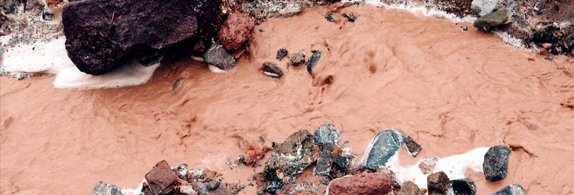
The Associated Press reported in the Denver Post, but not the Albuquerque Journal, that historic rains last week flooded the canyons coming down from Los Alamos and emptying into the Rio Grande.
It’s a worrisome thought. Many canyons around the Los Alamos National Laboratories (LANL) were used as dumps for radioactive waste during the cold war. And though the government and lab officials always downplay the public health risks involved, other sources, NGOS, Santa Fe residents and many of us down river from LANL, aren’t mollified by such pats on the head.
And anyone who has read on-line the Los Alamos Historic Document Retrieval and Assessment report (LAHDRA) from the Centers for Disease Control and Prevention (CDC) realizes it’s not silly or “unscientific” to be concerned.
The LAHDRA report describes massive “airborne plutonium releases” from LANL from l948 to 1978. What goes into the air, of course, comes down on land and water. LAHDRA says that if the releases were as high as records from LANL’s own “industrial hygiene staff indicate” then “plutonium releases from LANL could easily exceed” the “airborne plutonium release totals from the (plutonium) production plants at Hanford, Rocky Flats, and Savannah River combined, even without the others sources and other years at LANL included.” And the LAHDRA report confirms that “liquid radioactive waste was discharged” into Acid and Pueblo Canyons “without treatment or monitoring from l945 to 1950.”
The masterminds of the arms race didn’t know much about geology, hydrology, or weather history and climate science. No one must have thought that the stuff they poured into canyons would reach the river, even if it was in million-gallon deluges of polluted water, and that canyons carry water downhill to the river.
Their disposal method was “‘kick and roll.’ They would just put barrels of waste on the edge of the canyon and kick them and watch them roll,” Joni Arends of Concerned Citizens for Nuclear Safety in Santa Fe was quoted as saying.
Environmental writer Laura Paskus in a 2003 piece in High Country News reported that LANL admitted in l981 to having dumped “about 30 million gallons of untreated wastewater, contaminated with radioactive sludge” into a tributary of Acid Canyon on between l943 and l951.
I quote these varied sources to emphasize that worry over flooding in canyons around Las Alamos is not just the suspicions of “crank environmentalists.” And I have the feeling that these scattered reports indicate much deeper problems on the Pajarito Plateau. Paskus gives us a clue. In l990 the Department of Energy ordered LANL to take stock of its waste management problems. “The lab reported it had 2,124 contaminated sites across its 27,500 acres, including everything from landfills to high explosives firing ranges.”
Ecologist Barry Commoner’s laws of ecology include two vital insights. One is that everything is connected to everything else. The other is that everything has to go somewhere. In the case of Los Alamos National Labs, their “legacy waste” from the Cold War, seems without a doubt to be heading to the Rio Grande, and to all of us downstream from it.
Maxwell Museum of Anthropology Is Not The British Museum, But…
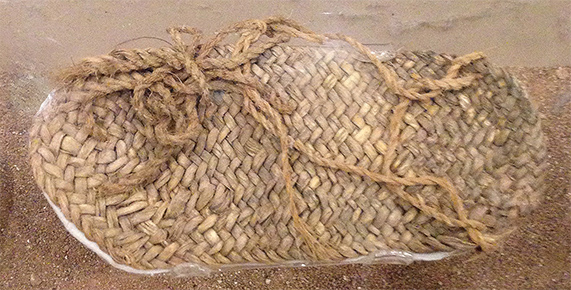
A carefully woven, yucca fiber sandal, sized to fit a young child, sits in a case in the Maxwell Museum of Anthropology on the UNM main campus. It’s part of the museum’s collection of artifacts from Chaco Canyon and other pre-conquest peoples in New Mexico, including the Mimbres from the southwestern part of the state.
If that sandal were in the British Museum, perhaps it would have been the subject of an essay by the museum’s director Neil MacGregor in his fascinating book A History of the World in 100 Objects. MacGregor covers everything from a Clovis (N.M) spear point from nearly 13,000 years ago and the Rhind Mathematical Papyrus from around 1550 BC in Egypt to a coin with the head of Alexander the Great, a l9th Century Hawaiian Feather Helmet, and a credit card.
MacGregor wrote that his book “tries to tell a history of the world in a way which has not been attempted before, by deciphering the messages which objects communicate across time – messages about peoples and places, environments and interactions, about different moments in history and about our own time as we reflect upon it.”
The child’s sandal from Chaco Canyon was woven around 1100 A.D.
There’s only one of them. It was crafted for the left foot and it seems to be in pristine condition. Perhaps it was never used. I was reminded of those single shoes one sees in the street from time to time. I wonder if the child lost the other one and was scolded for carelessness, or if time and the weather washed the other one away, or if the right footed sandal just wasn’t made, signaling some family tragedy.
One can see the skill and loving care that went into weaving that little sandal. In 1100 AD its creator was living in the high point of Chacoan civilization, perhaps less than 50 years before its collapse. The child it was made for might have lived long enough to have experienced the traumatic exodus from the canyon during the latter stages of what would prove to be a devastating 50 year drought that started probably around 1130 A.D.
The great buildings of Chaco, Pueblo Bonito among them, the hundreds of miles of roads, the great kivas and other ceremonial areas of the canyon might well have still been carrying on the way they had for 200 years when that child lost her other sandal. The early spring sprouting of the great fields of maize might have been part of her experience. Perhaps she weeded the fields and helped with the harvest.
The same person who made the sandal might have been a person who spent time chipping some of the millions of stones that went into the walls of Pueblo Bonito, or she might have helped plaster the outer walls, or have danced in the long lines of corn maidens, if such modern forms evolved from Chaco. There is no direct evidence of the gender of the maker.
That little sandal represents to me a manifestation of a culture of care and nurturing that seems to be characteristic of Puebloan life as I’ve observed it from afar. The devotion to detail, to craftsmanship, to patience and beauty, are the same human virtues that went into the creation of those tremendous buildings, stone by stone, or drilled the tiny holes in turquois and shell beads, or painted the black and white pottery mugs and pots with such exquisite forms, or who stargazed and kept track of the heavens over generations, and helped design buildings as astronomical observatories.
Who knows what kind of sandals that child wore as an adult as he trekked out toward the wet uplands leading to the Rio Grande, escaping the drought. Were his adult sandals worn and battered, with gaping holes in the heels, like the examples in the museum of other foot gear apparently tossed after years of use?
All that’s certain is that an adult made sandals for a child. And that one of them remains, and is a mystery of sorts on a micro scale, like the whole Chacoan complex itself.
Everything human-made we’ve seen in Chaco was crafted with the utmost care. It’s not the same way in our mass-produced, throw-away culture of course, except with the most personal objects and machines we rely on. The great care-creators, the repairers of objects, the seamstresses, the mechanics, the fixit masters who bring back to life precious pens or who mend a father’s jacket for a son are rarities in our world. But we still long for that kind of care, in our own way. Objects we use and repair over long periods of time have a special meaning and a kind of power in them.
I look at that child’s sandal from Chaco as a work of domestic art in a time of growing scarcity, a time that could prove to be very much like our own. There’s a sadness in it. That tiny woven work of perfection in the Maxwell Museum was never used. When I first saw it, I thought of my own mass-produced Tevas. My feet love those worn, smooth and sturdy things. I’ve made them my own from years of use. And I can’t help but feel for that child who didn’t wear her beautiful sandals, break them in, and look forward to wearing them because they felt so good.
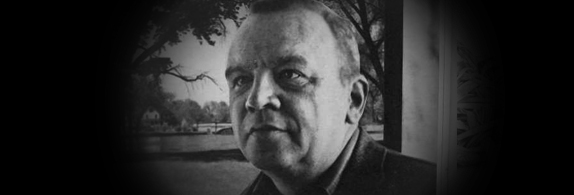
The coming of fall intensifies the gladness many of us feel when we think of how lucky we are to be New Mexicans. Whenever cold mornings signal the relief of autumn is on the way, I think of my late friend Win Scott, one of America’s most generous poets, who cared for writers young and old, who encouraged the best in everyone he knew, and who had a passion for New Mexico that rivaled that of D.H. Lawrence.
In one of Win’s most beloved essays, “A Calendar of Santa Fe,” which appeared in his 1961 prose collection, Exiles and Fabrications, he quoted Lawrence’s famous sentences: “I think New Mexico was the greatest experience from the outside world that I ever had. It certainly changed me forever. Curious as it may sound, it was New Mexico that liberated me from the present era of civilization, the great era of material and mechanical development….The moment I saw the brilliant proud morning shine high up over the deserts of Santa Fe, something stood still in my soul, and I started to attend.”
In the late l950s when Win Scott first arrived in Santa Fe from New England where he had been the literary editor of the Providence Journal and Evening Bulletin for over a decade, he began immediately “to attend” to his new home.
In the October entry in “A Calendar of Santa Fe” he wrote, “Across the thin air and big sky, moonlight here is titanic. Before you see the moon, but as it is rising behind the Sangre de Cristos, a glowing milkiness fills the hollows behind the near, dark foothills….Friends of ours from New York rode their horses out to the desert lands beyond Tesuque just north of us, to see that vast waste in full moonlight; they say it was like an evaporation, it was like gazing into nothingness. There was no frame of reference. Nothing but a mist of pearl.”
Four months later in mid-January, he wrote “we had our first real snow, the mountains gone, the land closeted with storm. It came down with such a furious quickness, three or four inches in a couple of hours, and on till there was about seven inches, very wet, all the trees and walls cottoned with it. During the storm robins flocked into the cedars and hundreds of jays wheeled in excitement and lighted in blue rows on all the wires. The snow stayed a day or so. Here the powerful sun makes short work of it. And on the twenty-seventh of the month I saw two violets in bloom by a south wall.”
As a critic and a poet, Win received as guests many of America’s iconic writers. “Spectacular as this country is, as with any other, you become accustomed to it. I don’t mean it could as well be the plains of Kansas, for light and the seasons are always busy arranging its heights and depths, but you get familiar even with that. Still, if you go away a little while and return, there is the awed wonder afresh again; or if in a sense you look consciously after some days of disregard, you catch a new drama….And sometimes, you see it all anew because somebody is newly arrived with whom you see it. The other afternoon I stood in front of the Folk Art museum…with William Carlos Williams. We gazed out across the pinon-pocked foothills flounced with green cottonwoods and ‘accented’ by poplars in the seemingly arrested sunlight. He said, ‘It looks like eternity’.”
Win was famous in his time. He seemed to have known every writer in America. But history has obscured him. I don’t know why. Only a few of his poems have been anthologized. But every young poet in the early l960s probably made a pilgrimage to see him in his house off the Alameda in Santa Fe. Win would serve us “bourbon and branch water” in very tall glasses with little ice. He worked through more than a half a dozen of those during the day himself. He told us to keep working, and to keep attending to our lives and to where we were and what we were really thinking and feeling.
In his great notebooks, published as “a dirty hand” in l969, he wrote what he told us: “What can one do but go on writing what one wants to write? No other course is interesting.” And “One suffers a kind of fatigue with repeated rejections. Still, I have started a new long poem. (I think.)Yesterday. – This business of writing what no body wants.” In another passage he wrote, “As the years go by one grows so mad to try to write well that the desire comes to have a moral basis.”
When young people sat at his kitchen table, trying to nurse a bourbon, he’d speak as he would in his notebooks, “One has to learn to trust one’s self. That sounds simple-minded perhaps. But I think it isn’t. In the long run it is all one can do.” He’d smile and say “Contrast ‘business ethics’ and the ethics of art. Nobody writes a poem hoping it will wear out in four or five years.”
Before his death, perhaps from bourbon and sleeping pills, in 1967, he wrote “I lead a bourgeois life – wife, children, a rather big house – all that – plenty of money. Poetry out of this environment? One’s mind and heart can supply sufficient suffering anywhere.”
In a note left by him before he died he wrote this:
Sex
Art
Death.
Should I weave
An acrostic
Daring us both to read my three
Themes spelled out?
In a poem he wrote to William Carlos Williams (Bill) in his book Change of Weather are lines that make it clear why so many young people, and older poets, loved Win Scott. He talked about “The beautiful ear of an old pro./Variation – I’m all for it --/The stain of personality – but each man for himself, /That or no real poems.” Near the end he wrote: “There’s so much – even at my age – /Still to learn; so see better and/So to write it better./Most of all to stay alive. “
He concludes the poem to Williams:
Thanks, Bill, for all those leaves
All those flowers all
Those nights and mornings –
Especially the mornings and the
Casual gesture of a magician
With which you held
Sunlight’s each momentary flash
For good and always:
Just for their own sakes,
Despite “the bomb” – and all that –
One wants – like Beethoven – to
Conclude with the human voice
In joy.”
(All images are property of their respective owners. Very Large Array by Chuck Coker; Canyon flooding by Kai Shreiber.)

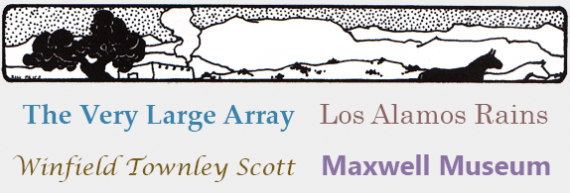


Responses to “Provincial Matters, 9-30-2013”